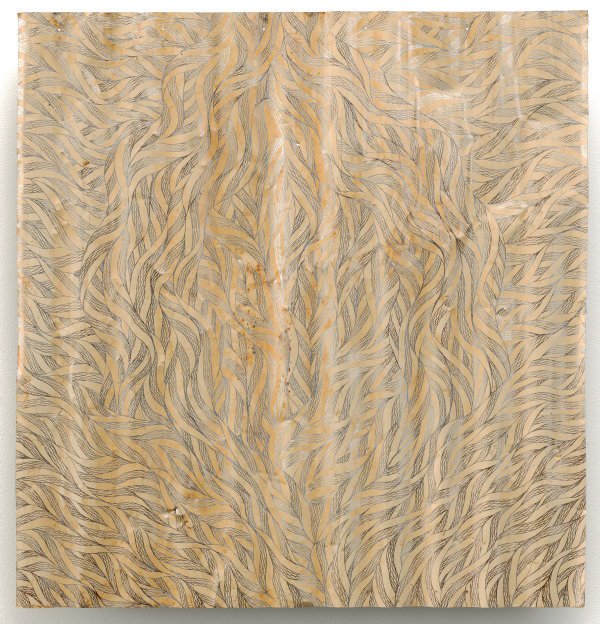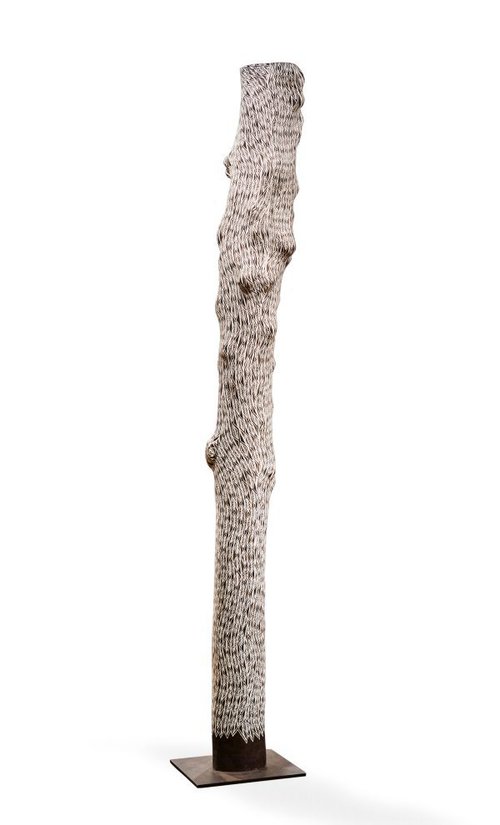-
Details
- Place where the work was made
-
Yirrkala
→
North-east Arnhem Land
→
Northern Territory
→
Australia
- Date
- 2021
- Media categories
- Sculpture , Metalwork
- Materials used
- steel
- Dimensions
- 96.0 x 91.0 cm
- Credit
- Mollie Gowing Acquisition Fund for Contemporary Aboriginal Art 2021
- Location
- North Building, ground level, Yiribana Gallery
- Accession number
- 172.2021
- Copyright
- © Gunybi Ganambarr
- Artist information
-
Gunybi Ganambarr
Works in the collection
- Share
-
-
About
Gunybi Ganambarr began his career as revered yidaki player and with an intimate knowledge of wood, later began to carve and paint cormorants. Soon after making his mark in the art world his practice shifted dramatically, and frequently. He began to experiment, calling on over a decade of skills developed as a builder. Not using straight larrakitj, but instead deliberately picking materials that had knobs, twists and turns, the imperfect picks. Cutting into barks, building the surface of pigment up, painting on both sides of barks, pushing the material and its possibilities as far as his imagination would take him. He began to utilise negative space on the materials, moving his patterns with the flow of the wood grain, putting small sculptures within his larrakitj, until finally, he decided to ask Elders for permission to use discards, waste material including rubber and metal. This was a departure from tradition, but not really. It is lore to use what comes from the land and so he argued that if it has been discarded and becomes part of the landscape, then it is not breaking tradition. It is recycling, cleaning up land and innovating cultural practices all at once. It was then that his practice had changed visually, materialistically, and spiritually - making beautiful, making sacred what most call waste. Ganambarr was awarded the Telstra National Aboriginal and Torres Strait Islander Award in 2018, the Western Australia Indigenous Art Award in 2011 and the Xstrata Emerging Indigenous Art Award in 2008.
The art centre documentation for the work states:
‘This artwork identifies the reservoirs of the Ŋaymil/Datiwuy clan. Ŋalkan is an area on Ŋaymil land and sea between the Gurrumuru and Cato Rivers that run into the Arnhem Bay. Within this area is another watercourse that leads up into a sacred area of a freshwater spring or Milŋurr with special qualities called Darrawuy. Here Djanda, the sacred goanna swim in the lagoon created by the spring, their actions as they swim causing patterns to be made on the surface that is covered by the totemic water weed Darra. The sacred clan design is a manifestation of these patterns created at Darrawuy lagoon. Others inhabit these waters. Warrukay or Murrukula, the Barracuda, an indicator of power for the Ŋaymil. It spends most of its time in the saltwaters. At certain times Warrukay will make its way up to Darrawuy bringing the ‘contamination’ of saltwater (the mother) with it. The mixing of this saltwater with the fresh has connotations of fertility. Darrawuy is a place of fertility. Souls of Ŋaymil are both delivered to and from this point between worlds real and spiritual. As the sacred songs used in mortuary are cyclic, narrating the ancestral events of the original creator beings, so is the journey of the Yolŋu soul. The foundation of the Dätiwuy clan stems from the actions of various Waŋgarr beings- ancestral forces that shaped the world in the time before morning. Amongst the beings who impinge upon the creation of Dätiwuy land and identity are the Thunderman, the Djaŋ’kawu sisters, and the two sharks (Mäna); one from the Djambarrpuyŋu clan and one from the Dätiwuy/Naymil clans. The link between the Ŋaymil and Dätiwuy clans is so close that they share the same Waŋarr and Maḏayin (sacred law). In a meeting between the ancestral sharks of the Djambarrpuyŋu, Datiwuy and Ŋaymil sharks that took place on Dätiwuy land at Bulurruma the Djambarrpuyŋu shark was in flight from the Djapu clan area. The Ŋaymil and Dätiwuy sharks waiting for him there suggested that he run south towards Blue Mud Bay and declared that they would remain where they were. He responded by suggesting that the two others could join together. The Ŋaymil and Dätiwuy sharks said they would remain there for good. The other shark splashed water before going down to Blue Mud Bay and the two lay in the water and put their heads together. The huge expanse of Arnhem Bay is almost like an inland sea with enormous volumes of water moving in and out on the change of tide. The currents and tides in the Bay, which is also fed by three large rivers, are very forceful. The feathered dilly bags that Dätiwuy elders hold in ceremony echo the jaws of Warrukay the barracuda whose mouth is a vessel of threat and power. Barracuda teeth and the spines of Namal, the ancestral stingray who travels over land to create freshwater wells on the beach at Rorruwuy, are the manifestation of the dangers of tackling the Dätiwuy.’ -
Places
Where the work was made
Yirrkala
-
Exhibition history
Shown in 1 exhibition
Yiribana Gallery: opening collection display, Art Gallery of New South Wales, North Building, Sydney, 03 Dec 2022–29 May 2023
-
Bibliography
Referenced in 1 publication
-
Salon Art Projects, Murrŋiny: a story of metal from the east, Darwin, 2021, (colour illus) pg. 12. exhibition catalogue
-



